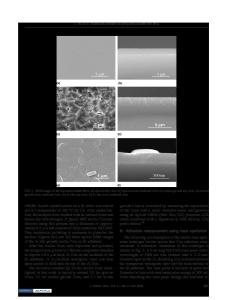Evolution of Structure, Composition, and Stress in Nanoporous Gold Thin Films with Grain-Boundary Cracks
- PDF / 673,061 Bytes
- 10 Pages / 593.972 x 792 pts Page_size
- 15 Downloads / 391 Views
UCTION
NANOPOROUS gold (np-Au) has received a growing amount of attention recently, due to its potential applications in areas such as sensing, actuation, catalysis, and supercapacitance,[1–4] all of which would benefit from the high surface-to-volume ratio and noble-metal chemistry of np-Au. Nanoporous noble metals are formed by a selective dissolution process called dealloying, during which the less noble atoms (e.g., Ag) are dissolved from a precursor alloy (e.g., Au-Ag), leaving behind a nanoscale, interconnected network of Au ligaments and open pores.[5–7] Although one study of the mechanical properties of np-Au was first published 16 years ago,[8] most research on this material has focused on its synthesis, structure, and mechanism of formation. Several studies have concentrated on the deformation mechanisms and ligament strength of np-Au,[9–15] and this area appears to be gaining research attention. Li et al.[8] analyzed the failure behavior of np-Au beams of various ligament sizes using a three-point bending method, and reported a sample-size-driven ductile-to-brittle transition in np-Au. Biener et al.[9] calculated the hardness and yield strength of np-Au based on nanoindentation measurements and found that the yield strength of np-Au was ~10 times larger than that predicted by the Gibson– Ashby scaling laws.[16] Volkert et al.[12] reported a high yield strength of 1.5 GPa for 15-nm-diameter np-Au ligaments by uniaxial compression, which approaches the theoretical strength of Au. However, our preliminary work[17] conducted in conjunction with the current study (described in this article) suggests that the strength YE SUN, Graduate Student, and T. JOHN BALK, Assistant Professor of Materials Science, are with the Department of Chemical and Materials Engineering, University of Kentucky, Lexington, KY 40506-0046. Contact e-mail: [email protected] Manuscript submitted October 23, 2007. Article published online September 16, 2008 2656—VOLUME 39A, NOVEMBER 2008
of bulk np-Au measured by microindentation may be significantly lower than the values reported by Biener et al.[9] and Volkert et al.,[12] depending on the initial alloy composition and final microstructure after dealloying. The mechanical behavior of np-Au is not completely understood and requires further investigation. Thin films of np-Au can be readily produced, with the advantage that the dealloyed structure is uniform through the thickness. Most studies of np-Au thin films[18–20] have used broad, freestanding films. However, these are difficult to handle and fabricate into structures. Producing np-Au thin films supported by a substrate, which is the aim of the current study, may help solve the problems associated with the instability of freestanding np-Au films. Such an approach also lends itself to wafer curvature measurements of np-Au film stress at various processing intervals, as well as to an evaluation of the mechanical behavior of np-Au film as a function of temperature.[21] In this article, the structure, composition, and mechanical behavior of np-Au thin
Data Loading...











